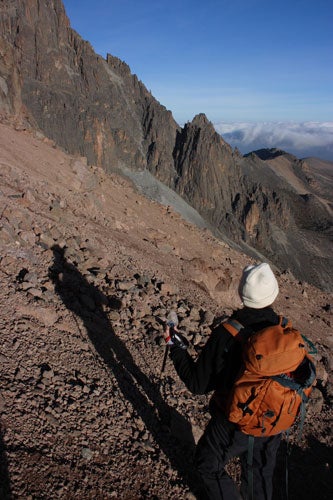Trail Of The Unexpected: Mount Kenya
Flora, fauna and heavenly vistas

God, they say, moves in mysterious ways. Even so, I wasn't expecting His wrath to be meted out by means of textile perforation. Plague, possibly, or even pestilence. But no. Ruefully holding my spanking new merino thermals aloft in the sub-zero hut, I surveyed the gaping holes. Ngai – the Kikuyu deity on whose lair, the peak of Mount Kenya, I was preparing to intrude – had decided to demonstrate his displeasure by inflicting chilly shoulders on me. Him, or a nesting dormouse munching its way through my precious woollens at Shipton's Camp. Either way, I was in for a nippy climb.
Given the carnival of animals that had trilled and snuffled the soundtrack to my three-day ascent, I wasn't entirely surprised. If conquering Africa's second-loftiest peak isn't exactly a leisurely Sunday stroll, it is – literally – a walk in the park; the 71,500 hectares of Mount Kenya National Park, designated a Unesco Biosphere Reserve, offer a lot more than standard peak-baggers' fare. Its jagged pinnacles – the eroded core of a long-extinct volcano – rise from broad shoulders covered with a variegated pashmina of vegetation and populated by a bountiful menagerie. An ascent isn't measured so much by altitude as by species.
We had joined the trail at the park's Sirimon Gate, where a platoon of zebra stood at attention shoulder by striped shoulder in a military-style send-off. Our path delved between the liana-festooned cedars of montane forest, studded with the vivid florets of red-hot pokers. Turacos (pictured) whirred, baboons shrieked, elephants scattered along the path and a brief flash of fawn ahead signalled the departure of a twitchy duiker. After an hour or so the cloud forest thinned, replaced by dense bamboo stands, usurped in turn by hagenia, furry with old man's beard. The end of that first day's climb saw us emerge onto moorland studded with giant heather; eland grazed just a couple of hundred paces from our bunkhouse at Old Moses Hut.
In absolute terms, the Sirimon Route isn't as tough as, say, some of Cornwall's more rugged sections of coastal path. Of course, that's easily said when porters are lugging your pack and a cook miraculously rustles up carb-packing, three-course feasts on a tiny camping stove. It also helped that the pace was carefully regulated by our thoughtful guide. Francis ensured that we gained altitude pole pole – slowly, slowly – by stopping at regular intervals to enlighten us. Over the course of the five-day hike, along glacial valleys and across chuckling streams, Francis discussed the reproductive habits of lobelias (stroke their phallic stems upwards to reveal fluffy purple blooms), the naming conventions of Kikuyu families, even hyrax digits – unexpectedly, these guinea-pig-like furballs have toenails instead of claws.
The second day's walk took us into the increasingly sparse zone over 4,000m, dominated by lobelias and giant groundsels, growing taller in stature as my breath became shorter. Among them flitted alpine chats and scarlet-tufted malachite sunbirds – possibly the world's most pedantically accurate avian name.
Our pre-summit stop, Shipton's Camp hut, nestles in a cirque overshadowed by three peaks: Nelion, Batian – the highest point (5,199m), but a technical ascent only accessible to experienced climbers – and our nemesis: Point Lenana, all 4,985m of it. On that sun-licked afternoon, hyrax frolicking among the lobelia around the hut, we jokingly complained that nobody had thought to pile an extra 15m of rocks onto Lenana, just so we could top 5,000m.
By dawn the next morning, the smile had frozen on my lips – the thought of hauling myself up a further 15m made my stomach lurch.
On waking in the darkness I'd donned every item of clothing I could lay hands on: T-shirts, fleeces, mouse-nibbled thermals, beanie, down jacket, two pairs each of socks and gloves; still the iceblocks that once had been my toes and fingers ached in the –15C chill. Above us, the dusting of snow on the peaks shone neon-bright in the moonlight, stark against the black rock as we started our final ascent. This, clearly, was how the mountain gained its English appellation – adapted from the Kamba name Kiinyaa, meaning ostrich, after its black-and-white plumage. Three hours of scrambling up scree slopes and beside tarns brought us to the final ridge leading to Lenana as nearby Nelion glowed tangerine in the dawn.
I could wax poetical and gush that my mind was alight with wonder at the heavenly vistas stretching in every direction from the peak: glaciers, patchwork farms, coffee plantations; even, so I'm told, Kilimanjaro, lurking on the southern horizon. In truth, though, my mind was swimming unpleasantly. I was shivering, gasping for breath, head pounding in the empty air.
I'm glad I made it to the top – for the views and, yes, the been-there smugness. But I was much more glad to get back down to Shipton's Camp, to a steaming breakfast and a sensible quantity of oxygen. Because the delight of the Mount Kenya experience is less about the summit and more about the beauty of the approach, the genial camaraderie around the huts' dining tables, and the plentiful wildlife. As long as it stays out of your thermals.
Traveller's Guide
The writer travelled with Exodus Travels (0845 863 9601, www.exodus.co.uk), which offers regular departures for Mt Kenya from January to October. An eight-day guided trip starts from £1,243 per person, including flights, four nights in mountain huts and one night in a lodge
Join our commenting forum
Join thought-provoking conversations, follow other Independent readers and see their replies
Comments